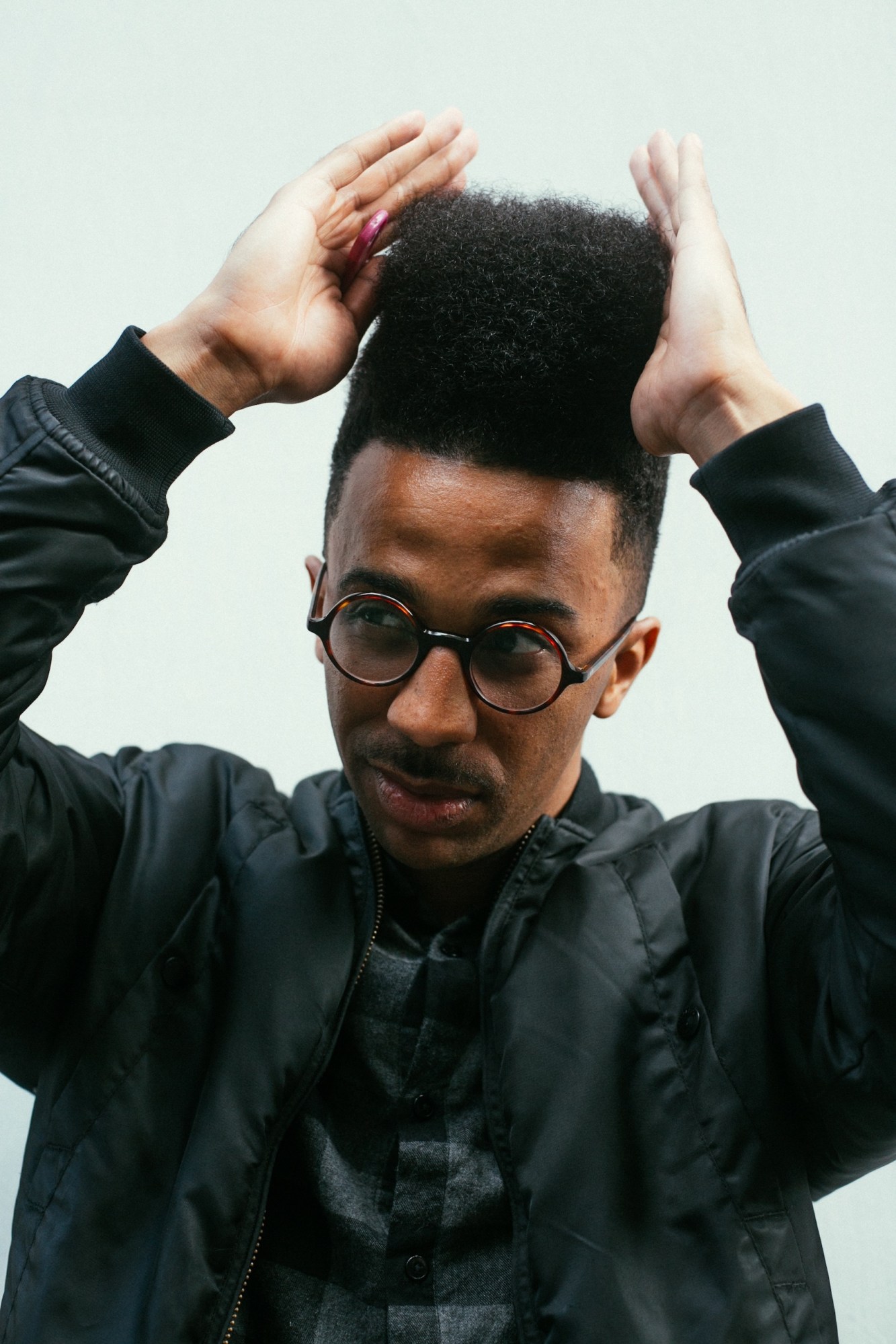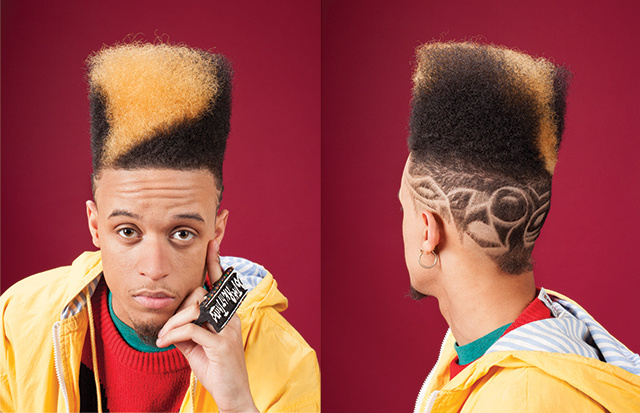During the Golden Era of Hip-Hop, black boys and men in the ‘hood were all about reinventing personal appearance. One hairstyle that emerged in the mid 1980s is the Hi-top fade. From black barbershops emerged hip-hop heads with their hair sculpted, with geometric precision, into a “flattop” box-like shape. The Hi-top, which is also commonly called the flattop fade, was one of the first defining hairstyles of hip-hop.
Stylized black hair communicates a certain power and pride. In the decade preceding the birth of hip-hop, the afro, perfectly picked into a halo, advanced the fist-clenched black power aesthetic. The waves that rolled through black men and boys’ heads in the 1990s represented a prettier and sexier look. The fade, a low cropped cut with the side of one’s head closely shaved, originated in the U.S. military at some point during the 40s and 50s, evolving into the flattop in the early 1980s, epitomizing the black cool of the Golden Era.
“Hip-hop impacted the way we dressed and how we wore our hair especially,” Greg “the Groomer” Cooper Spencer, told Ebony‘s Princess Gabbara. The New York barber said, “Before this period, we relied heavily on black leaders, such as Martin Luther King Jr., Malcolm X and Muhammad Ali who sported afros, to influence how we engaged in society in addition to our look.” He added, “Just as hip-hop emerged, so did the artists who made sure their hair and wardrobe stood out, along with their music.”

Rappers Big Daddy Kane, Doug E. Fresh, MC Rakim, Jazzy Jeff and the Fresh Prince, and Will Smith popularized the flattop in the 80s while they rocked the mic, donning the style like a crown. “The flattop was all about self expression and being different,” explains the 35 year-old barber Mike Vegas, who first cut his own hair into the style in 1988 after seeing Big Daddy Kane rocking it on Yo! MTV Raps. “You have to think about hip-hop, it was like our rock-n-roll, it was the rebellious sound of the time,'” says Vegas, who owns the barbershop Krome NYC. “When you were wearing a flattop you were like, ‘listen I’m me, I represent the new generation.”
Even white 80s rapper Vanilla Ice appropriated the culture and donned the fade. Christopher “Kid” Reid, from the hip-hop duo Kid n’ Play etched the high-rise cut into popular culture in the House Party movies. Kid and the rest of early hip-hop called the style the “Cameo cut,” named after Cameo’s frontman, Larry Blackmon, who is credited as the originator of the remixed fade in the 1970s. Ultramagnetic MCs’ CED-GEE verse on 1988’s Give the Drummer Some Lyrics, confirms as much: “Teach… them respect/ Hook ’em up just like a tape deck/Mono or Stereo, cuz I’m a real pro/ With a Cameo, and not an afro.”
But before hip-hop acts and New York crews adopted the Cameo cut as their own, pop icon Grace Jones cropped her hair for the 1980 cover of her fourth studio album, Warm Leatherette. (Some hip-hop enthusiasts argue that Jones wasn’t the first woman to fade her hair, but rather the Ancient Egyptian Queen Nefertiti.) On the black and white cover, shot by the French photographer and Jones’s then-boyfriend, Jean Paul Goude, the singer’s arms are folded, lips painted black, and she looks directly at the camera in a tapered, medium length fade. Jones used the cut to play up her masculine appeal, allowing the fade to subvert gender and traditional ideals of beauty. Jones admitted that even for her the fade represented a radical break. During an appearance on Live! With Regis and Kathie Lee, she described the experience of cutting her hair as a “sacred thing. It’s something that one really never does, and so when you do it, it’s so–I feel like a nun.” Regis Philbin tells her, “A lot of guys copy that haircut.” “It’s terrible,” says Jones, “for my next album cover, I’m not even using a photo of me because it’s going to look like I’m copying everyone else!”
In 2015, Jones inspired the fashion stylist Erykah Achebe to go to a barber and ask him to cut her hair into the style. “Being a huge of Grace Jones, it happened organically,” recalls the 30 year-old. “I had color in my hair at the time and I went to a barber and asked him to cut the color out and while I was there I said, you know what cut it lower, into a flattop.” She says, “I feel like it matches my style better. I’ve’ been through so many hair styles and I finally landed on something that suits me and that’s relatively easy maintenance.” Achebe says that although the fade is traditionally worn by black males the reactions have been mostly positive. “My mom actually hates the hairstyle” she confesses, but has learned to accept it. “The weird reaction seems to steam from the fact that it might seem a little strange for a black woman to be rocking this style but I have definitely seen more women recently rocking a flattop.” She credits the development to the burgeoning natural hair movement that has led more black women to forgo perms and European hairstyles.
For men the retro look that was considered played out by the early 1990s has come back in style. NBA stars Brandon Jennings and Iman Shumpert have resurrected the classic on the court. At former president Barack Obama’s 2009 inauguration, his nephew Avery Robinson sat behind Michelle Obama sporting an asymmetrical flattop with a part. There was a backlash to a teenager appearing on the world stage with the fade. In a bizarre turn of events, Chris ‘Kid’ Reid, who helped popularize the look, told TMZ that Robinson should, “get out of the time warp” and the flattop “now looks stupid to me.” The Los Angeles based hip-hop scholar and VICE News Tonight host Dexter Thomas, who maintains a hi-top, notes that when he reads the comments on clips of his HBO interviews, white commenters often call him “distracting.” The 32 year-old, who is currently writing his PhD dissertation on the rise of Japanese hip-hop says, “I’m often given unwanted advice: people will take you more seriously if you just cut your hair.” He declares, “I have no desire to do that. There’s something about the black punk aesthetic and community of the 80s and early 90s I want to embody.”
“It’s crazy to say, but the flattop brought me and my crew together,” admits Elijah Pryor of the New York based creative collective, Tribe NYC. In 2010, the members of Tribe found each other in the streets of Soho because they were all wearing flattops. “When I first started growing it ten years ago, it became like a math problem to me. I could cut it into shapes, throw bleach in it and have parts and designs cut into it. There were so many ways to finesse this haircut,” explains the Jamaica Queens native, who typically sees Vegas at Krome NYC every two weeks to keep up the high maintenance haircut. “The more I grow as a person, the more my hair follows my growth. It shapes the dimensions of my nose, my face, my head perfectly.”

In the photographer Awol Erizku’s 2013 VICE photo series Heads, the artist recreated a grooming chart typically found in black barbershops. Nine black males mostly wearing variations of flattops are pictured against a red backdrop. One has his name, “Steel,” cut into the back of his head; Another has a chain linking the red and green and black of the pan-African unity flag circling his fade, which is above an image of a young male with an angular hi-top. In the middle of the grid is Pryor, pictured, in the knowledge-is-power Malcolm X pose. His index finger is on his temple with his six-inch black and bleached orange fade towering into the air. He stares confidently at the camera, his flattop merging the echoes of early hip-hop’s self-representation. He is the image of blackness in control of its beauty, intellect and cool.

Credits
Text Antwaun Sargent
Photography (Top to Bottom)
Photography Stef Mitchell
Elijah: Sen Floyd and Dani B.
Dexter DJ Furth
Awol Erikzu, Heads, 2013, courtesy of the artist.
